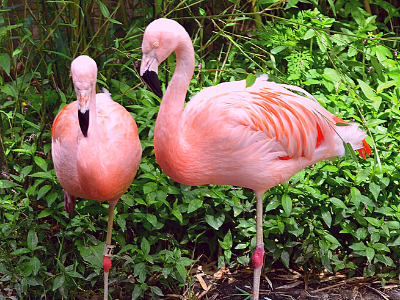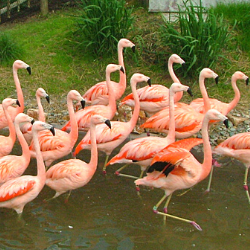When someone mentions “pink flamingos” what’s the first thing you think of? Is it the cheesy plastic lawn decoration or the majestically awkward bird? Here at the Akron Zoo, we obviously think of our Chilean flamingo flock. In fact, it’s hard not to when their Legends of the Wild habitat is near the entrance and our 23 birds can be heard honking quite loudly throughout the day. But, seeing as Pink Flamingo Day was started in 2007 to celebrate Don Featherstone’s iconic creation, we would be remiss not to think of a plastic flock as well.
In fact, it got us thinking: How exactly does a fake flamingo compare or, more appropriately, contrast to a real flamingo?
 Let’s start with habitat. The six species of flamingos are native to the warm climates of South America, Central America and Africa. They reside in mudflats or lagoons, where plenty of crustaceans, algae and small insects are present. Flocks range in size from hundreds to thousands of birds. This is a far cry from a pair “living” on a well-manicured lawn in sometimes snowy Massachusetts where the original plastic lawn ornaments were created.
Let’s start with habitat. The six species of flamingos are native to the warm climates of South America, Central America and Africa. They reside in mudflats or lagoons, where plenty of crustaceans, algae and small insects are present. Flocks range in size from hundreds to thousands of birds. This is a far cry from a pair “living” on a well-manicured lawn in sometimes snowy Massachusetts where the original plastic lawn ornaments were created.
Don Featherstone sculpted two flamingos in 1957 based on photos from National Geographic. One stood upright and the other was in a “feeding” position. When flamingos feed, they use their long legs to wade into the water, turn their bills upside-down and filter feed. By filter feeding, flamingos are able to use special structures in their beaks called lamellae to separate tiny food particles out of the water. If you happen to watch any of our birds feed, you may notice them stamping their feet. This is a natural behavior that helps stir up silt and sediment, allowing more crustaceans (or Mazuri flamingo pellets) to rise into the water column. In Featherstone’s defense, it would look a little weird to have a lawn flamingo with its head upside-down so we’ll give him half-credit for authenticity.
One trait fake and real flamingos share is their coloring! While the plastic varieties are almost always a vibrant pink color, real flamingos can vary along the spectrum from bright pink to pale pink and even to the more coral shade of our Chilean flock. Flamingos take a very “you are what you eat” approach to their coloring because it does, in fact, come from their diet. In their native habitats, the crustaceans they eat provide the carotenoids, which color their feathers. Here at the Akron Zoo, we feed Mazuri flamingo pellets, which are specially formulated to provide all the necessary nutrition the birds need, including carotenoids. Fun fact: Young flamingos are white or grey. It takes a couple years for them to turn fully pink because they need those carotenoid pigments to build-up in their bodies.
 The biggest discrepancy between these two versions of flamingos is longevity. The median life expectancy for flamingos can be 40-50 years but thanks to the high quality of care the birds receive at AZA institutions, they can live even longer. The majority of our flock is in their 30s and 40s, with one exception. Josephina hatched in 2015, marking the first time we ever had a Chilean flamingo chick here at the Akron Zoo. (Keep an eye out for her next time you visit—she’s band #15.) In contrast, the kitschy lawn flamingos can live ten times longer. Plastic can take an incredible 500-1000 years to decompose in a landfill. If you decide it’s time to retire your own personal flock, be sure to properly recycle them instead of putting them in the trash. It’s a responsible, easy decision to make to help protect wildlife!
The biggest discrepancy between these two versions of flamingos is longevity. The median life expectancy for flamingos can be 40-50 years but thanks to the high quality of care the birds receive at AZA institutions, they can live even longer. The majority of our flock is in their 30s and 40s, with one exception. Josephina hatched in 2015, marking the first time we ever had a Chilean flamingo chick here at the Akron Zoo. (Keep an eye out for her next time you visit—she’s band #15.) In contrast, the kitschy lawn flamingos can live ten times longer. Plastic can take an incredible 500-1000 years to decompose in a landfill. If you decide it’s time to retire your own personal flock, be sure to properly recycle them instead of putting them in the trash. It’s a responsible, easy decision to make to help protect wildlife!
While many people consider Featherstone’s original lawn flamingos to be an endangered species, keep an eye out when you travel because you never know when a small flock may appear in someone’s front yard. As for the Chilean flamingos at the Akron Zoo, be sure to spend a few minutes with them before you leave. They’re sure to brighten anyone’s day with their iconic pink plumage!
